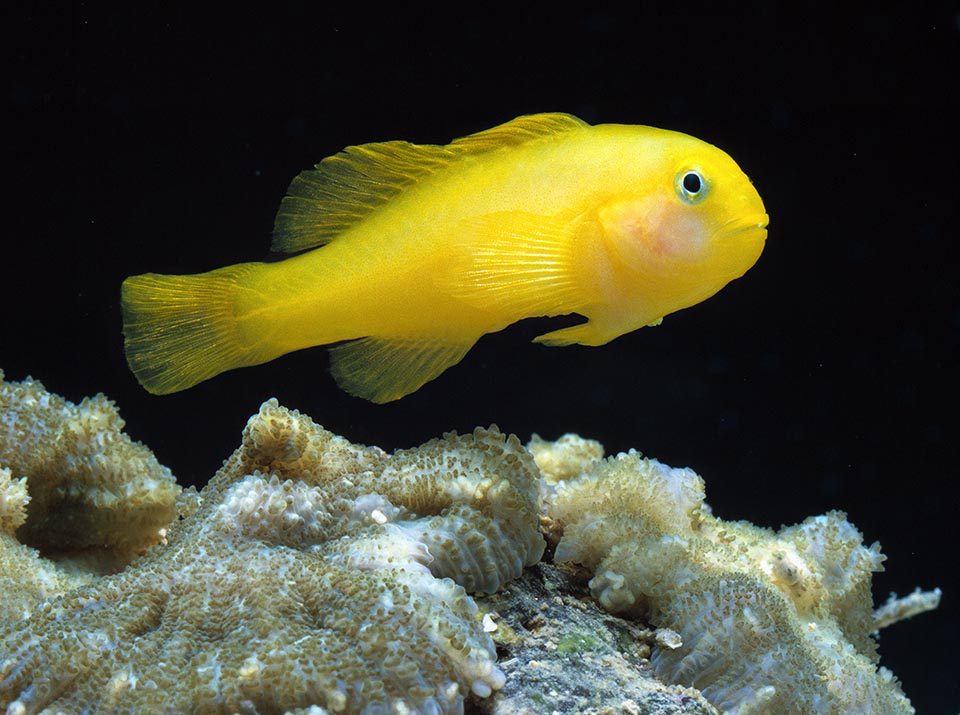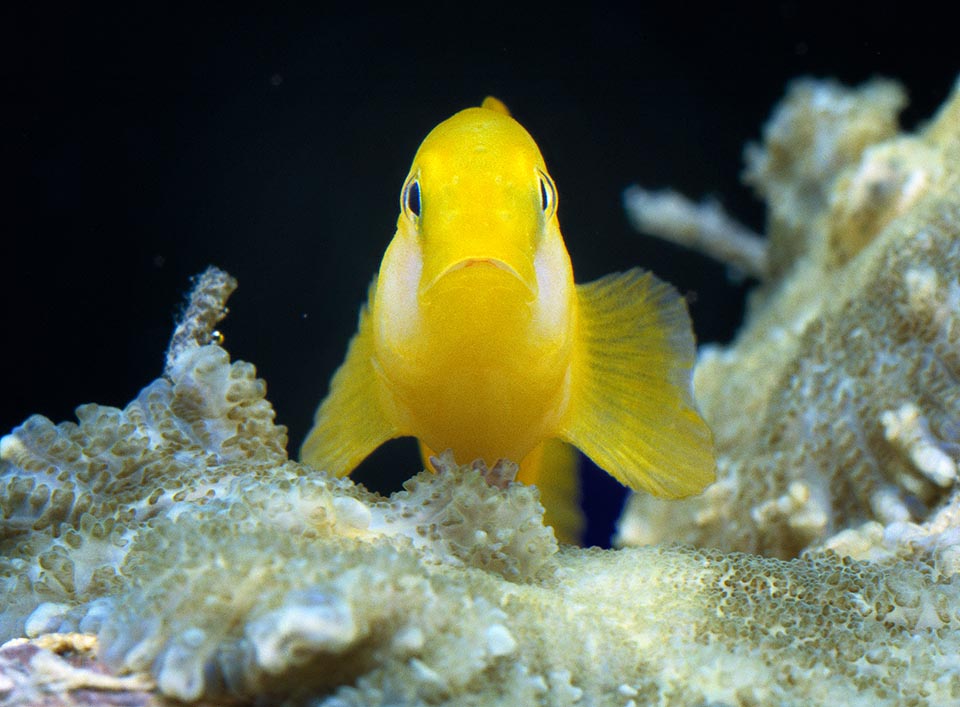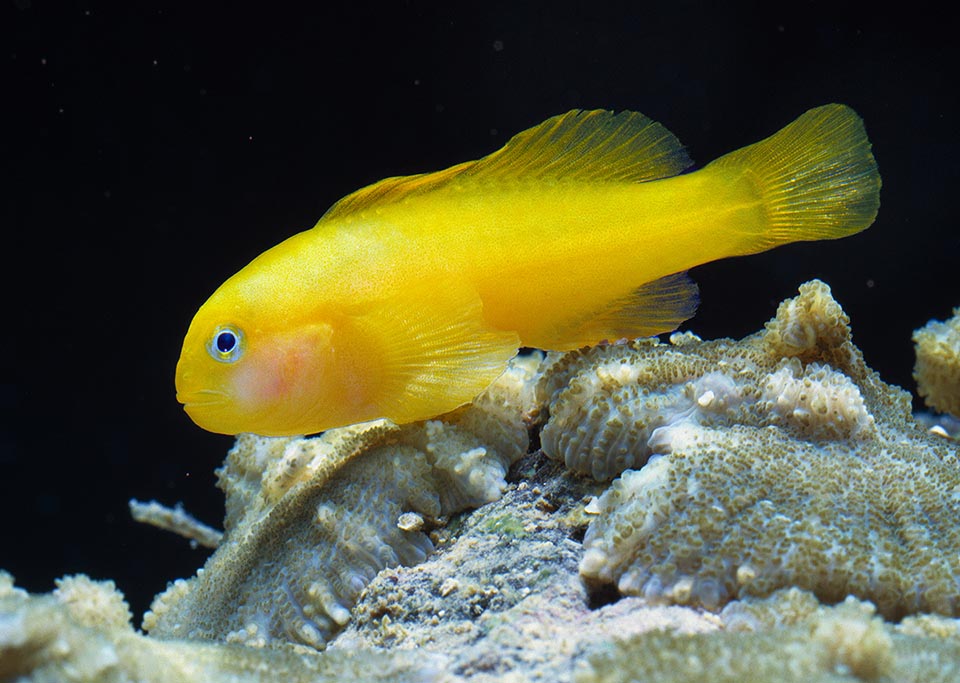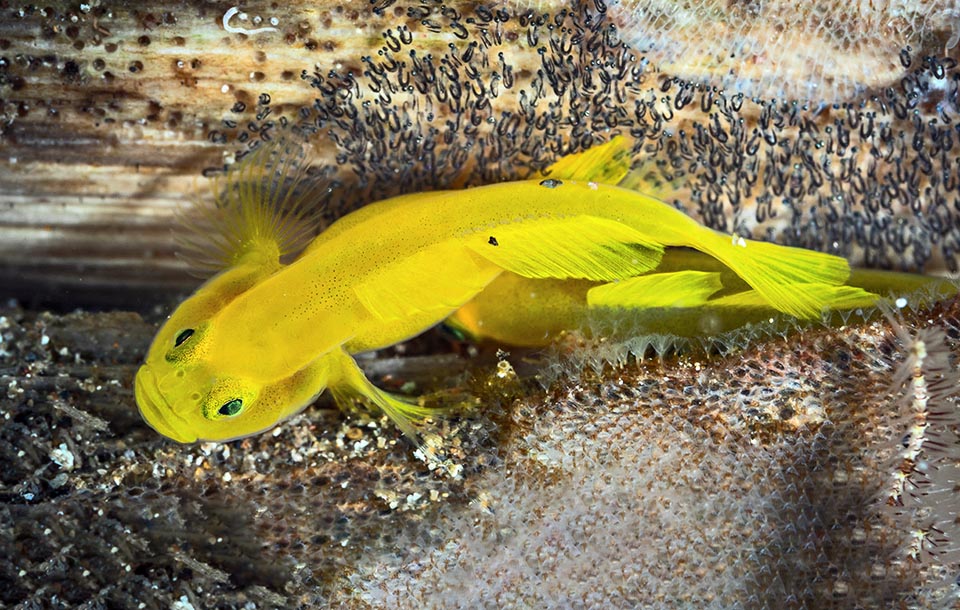Family : Gobiidae

Text © Giuseppe Mazza

English translation by Mario Beltramini

Present in the tropical waters of western Pacific, Gobiodon okinawae does not exceed 3,5 cm. Scaleless, it is protected by a poisonous mucus © Giuseppe Mazza
The cocky Okinawa goby or Yellow-coral goby (Gobiodon okinawae Sawada, Arai & Abe, 1972) is une of the smallest fish in the world.
Taxonomically it belongs to the class of Actinopterygii, the ray-finned fishes, to the order of Gobiiformes and to the endless family of Gobiidae, mainly present in the tropical and temperate seas, but also in the fresh and brackish waters, with about 250 genera and 2000 species.
The name of the genus comes from the Greek “gobius”, name the Romans gave to the gobies, and from “odus” = tooth, due to the showy teeth in respect to the size.
The name of the species “okinawae” = in Latin, “of Okinawa”, refers to an island of the Ryukyu Archipelago, south of Japan, where the individual with which the authors described the species was taken.

The livery, more charged in the males, is yellow with pale cheeks, at times slightly pinkish. It lives in small schools on the madrepores seizing the passing-by plankton © Giuseppe Mazza
Zoogeography
It lives in the Western Pacific tropical waters. Indicatively, we find it, starting from the Cocos Island, in Australia, Indonesia, New Guinea, Solomon Islands, Palau, Philippines, Taiwan and, as we have said before, in the southern part of Japan. Eastward, it reaches the Marshall Islands and southward the Great Barrier Reef.
Ecology-Habitat
It lives in the madreporic formations, in shallow waters, up to 15 m of depth. Like the Broad-barred goby Gobiodon histrio it loves settling among the coral branches of the genus Acropora and is protected by poisonous mucus, sour to the taste of the predators.

The males may transform into females and vice versa. These, after cleaning a corner for the nest, can lay even a thousand eggs, monitored for five days by the male © Giuseppe Mazza
Morpho-physiology
High and flat, it does not exceed the 3,5 cm of length. The first dorsal fin has 7 spiny rays and the second 10-11 unarmed; the anal 1 spiny ray and 9 unarmed; the pectoral ones and the caudal are rounded and the ventral fins are merged like a sucker in order to firmly fix on the madrepores and the rocks without having the risk of being carried away by the currents. The mouth exhibits, like the broad-barred goby, showy conical teeth, even if its diet is substantially planktonic.
The livery, darker in the males, is yellow with pale cheeks, at times slightly pink and this distinguishes it from the Gobiodon citrinus, quite similar, but with small bluish stripes.
Ethology-Reproductive Biology

Here the hatching. The larvae of Gobiodon okinawae metamorphose after one month of planktonic life. It is not an endangered species © Jon McClintock
The Okinawa goby is not a hunter but an opportunist. It waits by his house entrance for the food to pass in front and then swallows the prey. Ostracods, chaetognaths, pteropods and larvae of tunicates are usually its main dish. Like the broad-barred goby, it is hermaphrodite: the sex defines with the age and may change in the two directions depending on the circumstances. If, for instance, we put two females in a small aquarium, the biggest will become male, and if we have two males the smallest will transform into a female.
In the wild, after having well cleaned with the spouse the branch of madrepore chosen as nest, the female decorates it on every side with even a thousand of eggs, immediately fecundated by the male who will watch them for 5 days, until the hatching. The larvae metamorphize after about one month of life and when 40 days old begin to colour in yellow with a life expectancy of 2-3 years.
Like the Broad-barred goby (Gobiodon histrio), the Okinawa goby does not have foes and its fishing vulnerability index is very low, of 10 over 100, with populations which can double in less than 15 months.
→ For general information about FISH please click here.
→ For general information about BONY FISH please click here
→ For general information about CARTILAGINOUS FISH please click here.
→ To appreciate the BIODIVERSITY of BONY FISH please click here.
→ To appreciate the BIODIVERSITY of CARTILAGINOUS FISH please click here.
